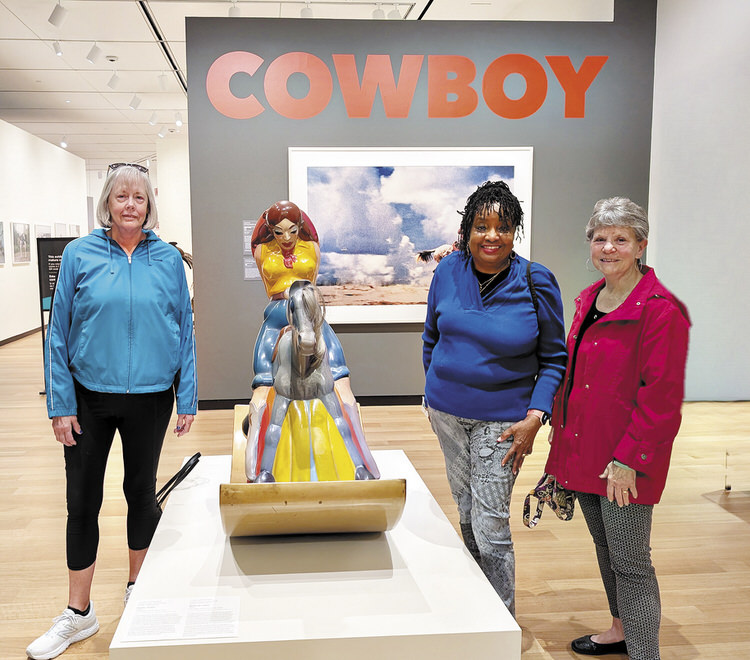
Voices United members Sara Shibley, Jackie Ford, and Vicki Baker visit the Amon Carter exhibit deconstructing popular mythologies surrounding the image of the cowboy.
Vicki Baker
He sits tall in the saddle wearing a broad-brimmed hat, boots, jeans, chaps, bolo tie, and an ornate silver belt buckle. With rugged features, his once-white skin now leathered and tanned from long periods spent under the sun riding the open range, he is a solitary, strapping man with the thousand-yard stare. Possessing an outsize swagger, a cigarette hangs from his mouth worthy of a Marlboro ad. He is a cowboy, and everyone knows he’s the coolest, calmest, most heroic dude in America history.
Of all the stereotypes that feed the dream of the American West, none is nearly as stubborn or rigid as that of the cowboy. He is everywhere. He is in film, literature, art, and television. He embodies the spirit of adventure and freedom associated with the untamed frontier. He symbolizes America’s desire of a never-ending movement westward, itching for adventure, resolute on manifest destiny.
Although the age of the historical cowboy has long gone, that symbolism still thrives today. Mostly rooted in fiction, it fails to accurately depict cowboy culture. New forms of representation have been created that are closer to the realities of cowboys in everyday life. Voices United visited the exhibit “Cowboy” at the Amon Carter Museum of American Art, which challenged this long-held myth of the American West.
But this is no ordinary Western art show. What is noteworthy is that Amon Carter has always shown a typical, Western, idealistic kind of vision of what a cowboy is, and in this case, it’s not. The 60 works from 27 artists address hot-button topics like race, religion, gender, and sexuality. The walls of the museum’s second floor are adorned with paintings, photography, films, sculptures, and mixed media works by and of individuals from under-represented groups recreating the cowboy persona in their own image.
Works showcased people of African heritage serving as cattle herders, horse wranglers, drivers, fiddlers, cowpunchers, cattle rustlers, cooks, singers, and bull-doggers. Others recognized the contributions of Filipino performers to Buffalo Bill’s Wild West Shows. Displays held family keepsakes such as jackets from the Indian National Finals Rodeo and a tooled leather belt buckle sporting an ancient Pawnee symbol. Latino artists created a multi-sensory experience to celebrate Norteño music from the non-binary culture. Works by women feminize this most masculine stereotype but also portray their grit and resilience in shaping the West.
There is no mythic figure that is more grand and complicated than the cowboy. Contemporary artists are making this figure their own. By giving the most honest portrayal the word “cowboy” has ever had, it has expanded the narrative of cowboy culture in a city that is a historic epicenter of ranching and wrangling.
Interested in immersing yourself in a variety of cultural experiences through food, museum exhibitions, book discussions, festivals, and more? Join Voices United, a 501(c)(3) organization of progressive women, on the first Saturday of the month at 11 a.m. in the clubhouse. For more information, visit www.voicesunitedrr.org.
